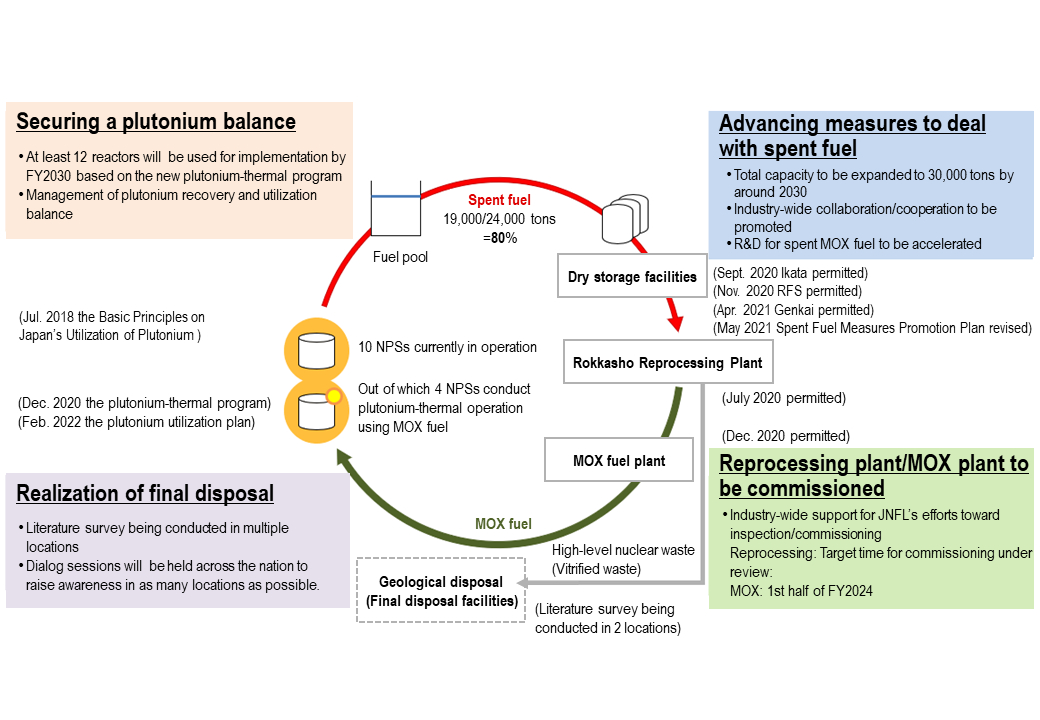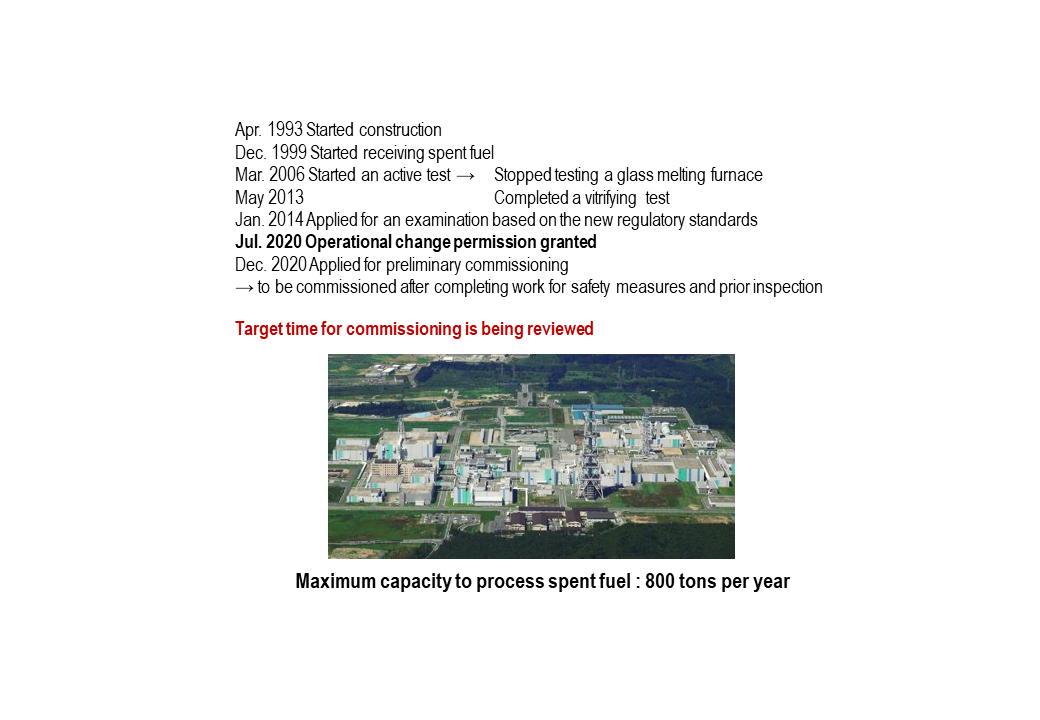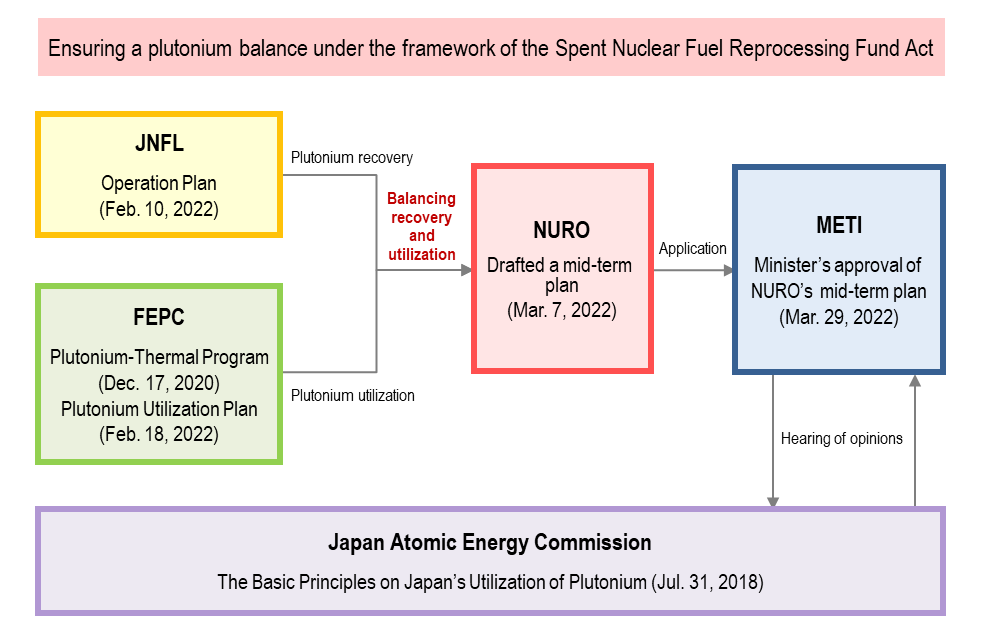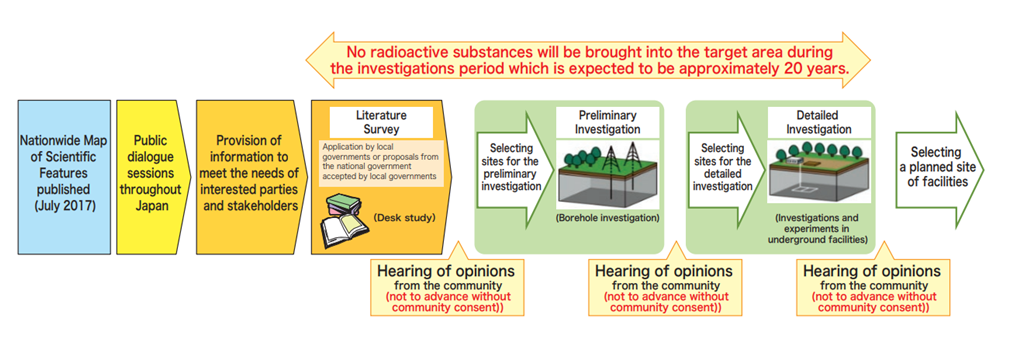Here’s more about the 6th Strategic Energy Plan
Nuclear power generation (Part 2)
Advancing nuclear power policy while obtaining public understandings
(in provisional translation)
(English ver.) 2023-04-24

On October 22, 2021, the Government of Japan published the 6th Strategic Energy Plan to show the direction of Japan’s energy policy. It explains our climate-related efforts to overcome challenges toward achieving carbon neutrality by 2050. It also covers policies to solve various issues in relation to the energy supply/demand structure of Japan. From the many topics covered by the 6th Strategic Energy Plan, this article, following Part1, focuses on our efforts regarding nuclear power generation and its future directions.
Nuclear fuel cycle and other policy measures
The accident at TEPCO’s Fukushima Daiichi Nuclear Power Station (NPS) in 2011 should be remembered and reflected upon earnestly. Based on this experience, Japan’s nuclear power policy prioritizes safety over everything else with utmost efforts being made to dispel people’s concerns. Upon this major premise, the latest Strategic Energy Plan states that nuclear power will continue to be utilized on the scale that is necessary as the previous plan stated. It indicates a ratio of nuclear power in 2030 being 20 to 22% of the total power mix, which is similar to the ratio shown in the previous plan. Let us look at salient points of the policy.
Efforts toward establishing the nuclear fuel cycle
If spent fuel from nuclear reactors is reused, it will contribute to more efficient resource utilization as well as reduction in high-level radioactive waste and its hazardousness.
Japan, as a country with limited resources, is advancing technologies which together are referred to as the “nuclear fuel cycle,” in which spent fuel is reprocessed, and uranium and plutonium are recovered to be reused as fuel for power generation.
The latest Strategic Energy Plan reiterates the importance of continuing efforts toward realizing the nuclear fuel cycle.
A reprocessing plant for spent fuel is being built in Rokkasho Village, Aomori Prefecture. In 2020, the Rokkasho Reprocessing Plant was granted permission by the Nuclear Regulation Authority (NRA) to start reprocessing operation as a result of the NRA’s examination. They concluded that the plant met their stringent standards (new regulatory standards) that had been formulated after the accident at the Fukushima Daiichi NPS. This marked a major step forward to realizing the nuclear fuel cycle.
The latest Strategic Energy Plan indicates that nuclear power businesses have published their plan to have at least 12 reactors operating on plutonium-thermal by FY2030, and it stresses the importance of reusing spent fuel and its reprocessing.
The “plutonium-thermal” program means that MOX fuel (recycled fuel), which is fabricated from a mix of uranium and plutonium recovered at the Rokkasho Reprocessing Plant, is to be used at a nuclear power station in its light-water reactor.
Nuclear power stations conducting or applying for plutonium-thermal generation

Japan will steadily advance its efforts toward establishing the nuclear fuel cycle on the major premise of “peaceful use” while contributing to nuclear nonproliferation and obtaining understanding from the international community. To this end, we will strictly adhere to the policy of not possessing plutonium without specific purposes, and do our best to reduce the stock levels of plutonium.
Proper management of plutonium utilization is being implemented with due consideration of the balance between plutonium recovery and consumption based on the Basic Principles on Japan’s Utilization of Plutonium (determined by the Japan Atomic Energy Commission in 2018). The government is also involved under the framework of the Spent Nuclear Fuel Reprocessing Fund Act that came into force in 2016.
More specifically, how much spent fuel is to be reprocessed and how much plutonium is to be recovered will be determined by a plan formulated by the Nuclear Reprocessing Organization (NURO) of Japan and then approved by the Minister of Economy, Trade and Industry. This plan is based upon the “provisional operation plan” showing how much capability the Rokkasho Reprocessing Plant possesses for plutonium recovery, and the “plutonium utilization plan” for each nuclear power station. Japan Nuclear Fuel Limited (JNFL) and the Federation of Electric Power Companies (FEPC) of Japan update their respective plans every year.
Literature survey started toward the final disposal of high-level radioactive waste
The final disposal of high-level radioactive waste is a common challenge facing all countries using nuclear power. It is a universal idea that the waste should be buried deep underground where geologically stable solid rock exists. In Japan, “disposal sites” are to be selected pursuant to the related laws through three stages, namely literature survey, preliminary investigation, and detailed investigation.
As the first step, a Nationwide Map of Scientific Features was published, classifying all areas of Japan taking into account scientific features such as volcanos and dislocations. Based on the information provided in the map, public dialog sessions took place across the nation. While these dialogs were in progress, a literature survey commenced in November 2020 in 2 municipalities of Hokkaido. In order to proceed to the next stage based on the result of such literature surveys, we will hear and respect opinions from the prefectural governor and mayor of the municipality in question. We will not move forward by ignoring those opinions.
We will steadily advance the literature survey currently underway. We will also hold dialog sessions across Japan aiming to conduct literature survey in as many areas as possible.
Advancing nuclear power policy by gaining broad understanding and cooperation
In order to advance nuclear power policy, public understanding is important not only in NPS locations but also in electricity consuming areas.
The latest Strategic Energy Plan clearly states that public hearing/public relations on nuclear power are indispensable. The government will come to the fore in an effort to gain understanding from a wide range of stakeholders in NPS locations and electricity consuming areas. In addition to physical dialog sessions and presentations nationwide, we will advance our efforts in an efficient manner by dispatching information through SNS and websites.
In order to appeal for the importance of utilizing various energy sources including nuclear power in a balanced manner, we initiated PR activities in February 2022 to create special websites and video clips, and widely spread such content through SNS in line with two policy PR campaigns in the national papers.
In areas where NPSs are located with nuclear power creating a major industry, people have concerns about their future, as the fact that NPSs have been shut down for a long time since the Great East Japan Earthquake has impacted those regional economies. To address such a situation, we will provide support tailored to each region’s needs by taking such measures as creating new industry and employment. We will do our utmost to build a trustworthy relationship through thoughtful dialog.
We will carefully advance our nuclear policy on the major premise of ensuring safety while releasing necessary information to the public.
Division in charge
About the article
Nuclear Facilities Development and Nuclear Fuel Cycle Industry Division, Electricity and Gas Industry Department, ANRE
Office for Regional Relations for Nuclear Facilities/Nuclear Energy Public Relations Office, Electricity and Gas Industry Department, ANRE
Radioactive Waste Management Policy Division, Electricity and Gas Industry Department, ANRE
About Special Contents
Research and Public Relations Office, Commissioner’s Secretariat, ANRE
![]() The original Japanese text of this article; Click here
The original Japanese text of this article; Click here



